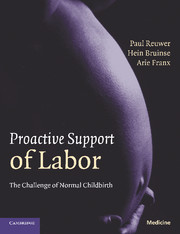Book contents
- Frontmatter
- Contents
- Foreword
- Acknowledgments
- Web-Forum
- 1 General introduction
- Section 1 A wake-up call
- Section 2 Back to basics
- Section 3 Proactive support of labor
- 12 Introductory synopsis
- 13 Nulliparous versus parous labor
- 14 Diagnosis of labor
- 15 Prevention of long labor
- 16 Personal continuity and continuous support
- 17 Amniotomy and oxytocin
- 18 Labor pain in broader perspective
- 19 Prelabor preparation
- 20 Medical pain relief revisited
- 21 Dynamic dystocia unraveled
- 22 Mechanical birth obstruction
- 23 Curtailed use of induction
- 24 Intrapartum care of the fetus
- 25 Prevention of litigation
- 26 Organizational reforms
- 27 Continual audit and feedback
- 28 Quality assessment
- 29 Hospital statistics
- 30 Sum of the parts
- Index
- References
19 - Prelabor preparation
Published online by Cambridge University Press: 08 September 2009
- Frontmatter
- Contents
- Foreword
- Acknowledgments
- Web-Forum
- 1 General introduction
- Section 1 A wake-up call
- Section 2 Back to basics
- Section 3 Proactive support of labor
- 12 Introductory synopsis
- 13 Nulliparous versus parous labor
- 14 Diagnosis of labor
- 15 Prevention of long labor
- 16 Personal continuity and continuous support
- 17 Amniotomy and oxytocin
- 18 Labor pain in broader perspective
- 19 Prelabor preparation
- 20 Medical pain relief revisited
- 21 Dynamic dystocia unraveled
- 22 Mechanical birth obstruction
- 23 Curtailed use of induction
- 24 Intrapartum care of the fetus
- 25 Prevention of litigation
- 26 Organizational reforms
- 27 Continual audit and feedback
- 28 Quality assessment
- 29 Hospital statistics
- 30 Sum of the parts
- Index
- References
Summary
In spite of convincing evidence that women's expectations and involvement in decision-making are critical to their satisfaction with the childbirth experience, many obstetricians still neglect prelabor preparation as a topic of real interest. Practitioners rather appear to rely on the assumption that everything will turn out okay and, should this prove not to be the case, that there seem to be few problems that cannot be handled with pain medication or cesarean section. Women's preparation for birth is generally left to antenatal classes conducted by self-employed birth educators or institutional physiotherapists. These teachers, however, are mostly far removed from actual childbirth practice. Left to themselves, professional status and job satisfaction suffer greatly. As a result, some birth educators even appear to be in open conflict with practitioners because they have developed little or no common ground. It is difficult to imagine how lessons in such circumstances could be reassuring to childbearing women.
Antenatal classes
The widespread popularity of antenatal classes attests to the desire of expectant parents for childbirth education and training programs for labor coping strategies. Despite the best of intentions, these classes may be counterproductive because certain expectations about labor support facilities may be roused that are unmet at labor and delivery. Classes vary widely in content, ranging from psychoprophylaxis to yoga, from the use of birth balls to specific breathing and pushing techniques, from reflexology to aromatherapy, and so forth.
- Type
- Chapter
- Information
- Proactive Support of LaborThe Challenge of Normal Childbirth, pp. 157 - 162Publisher: Cambridge University PressPrint publication year: 2009



